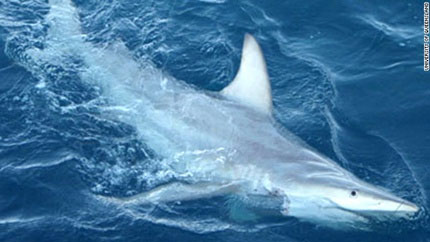Genetically modified sharks rise in the Pacific
A large number of the world's first transgenic sharks have been discovered at the Australian coast.
>>>Unexpected facts about sharks
Explaining this phenomenon, scientists believe that this is the transformation of animals to adapt to changes in the environment. They found 57 crosses between two common black shark and Australian black shark. Although they are two closely related species, they have a completely different chromosome structure.
Researcher Jennifer Ovenden from the University of Queensland said that these hybrid individuals could be born to adapt to the changing northern habitat. This is a permanent habitat of the Australian black shark, while the black fin shark usually lives only in the Southeast.
Ovenden said these were the first discoveries of breeding in sharks. It is possible that individuals of this species have already carried out interbreeding with other species close to their own when there is climate change in their environment.

57 hybrid individuals discovered over 2,000km of coastline have never happened.
These findings have been confirmed by DNA tests and other measurements. Scientists from many Australian universities, along with local departments, have carefully examined the information before announcing it to the press.
These hybrid sharks were discovered along the 2,000km Australian coastline extending from Queensland to New South Wales. The width of the area they appear with is quite large, surprising the researchers.
Ovenden commented: " Crossing the species in nature is extremely rare and the discovery of 57 individuals stretching over 2,000 km of coastline is unprecedented."
According to Jess Morgan, another researcher from the University of Queensland, another conception can occur in fish because eggs and sperm are distributed in the country. However, each species, especially shark, has a very accurate way of choosing natural mates to minimize the possibility of contact with other species.
Colin Simpfendorfer, a researcher from James Cook University seafood center, said the results will give scientists new opportunities to learn about one of the ocean's notorious predators.
- Using genetically modified foods is prone to cancer
- Genetically modified plants still cause doubts
- Genetically modified food in Vietnam ever since?
- Genetically modified salmon in the US is controversial
- Things you should know about GMO genetically modified foods
- Genetically modified insects threaten genetically modified plants
- He called on the EU to approve genetically modified corn by voting
- Legislation of genetically modified corn harmful
- Countering genetically modified corn causes cancer in mice
- Raising awareness about genetically modified organisms
- Genetically modified plants and the future in Vietnam
- DNA from genetically modified food goes straight into the human body
 Surprised: Fish that live in the dark ocean still see colors
Surprised: Fish that live in the dark ocean still see colors Japan suddenly caught the creature that caused the earthquake in the legend
Japan suddenly caught the creature that caused the earthquake in the legend A series of gray whale carcasses washed ashore on California's coast
A series of gray whale carcasses washed ashore on California's coast Compare the size of shark species in the world
Compare the size of shark species in the world